tire pressure MAZDA MODEL CX-5 2018 Owners Manual (in English)
[x] Cancel search | Manufacturer: MAZDA, Model Year: 2018, Model line: MODEL CX-5, Model: MAZDA MODEL CX-5 2018Pages: 628, PDF Size: 82.38 MB
Page 62 of 628
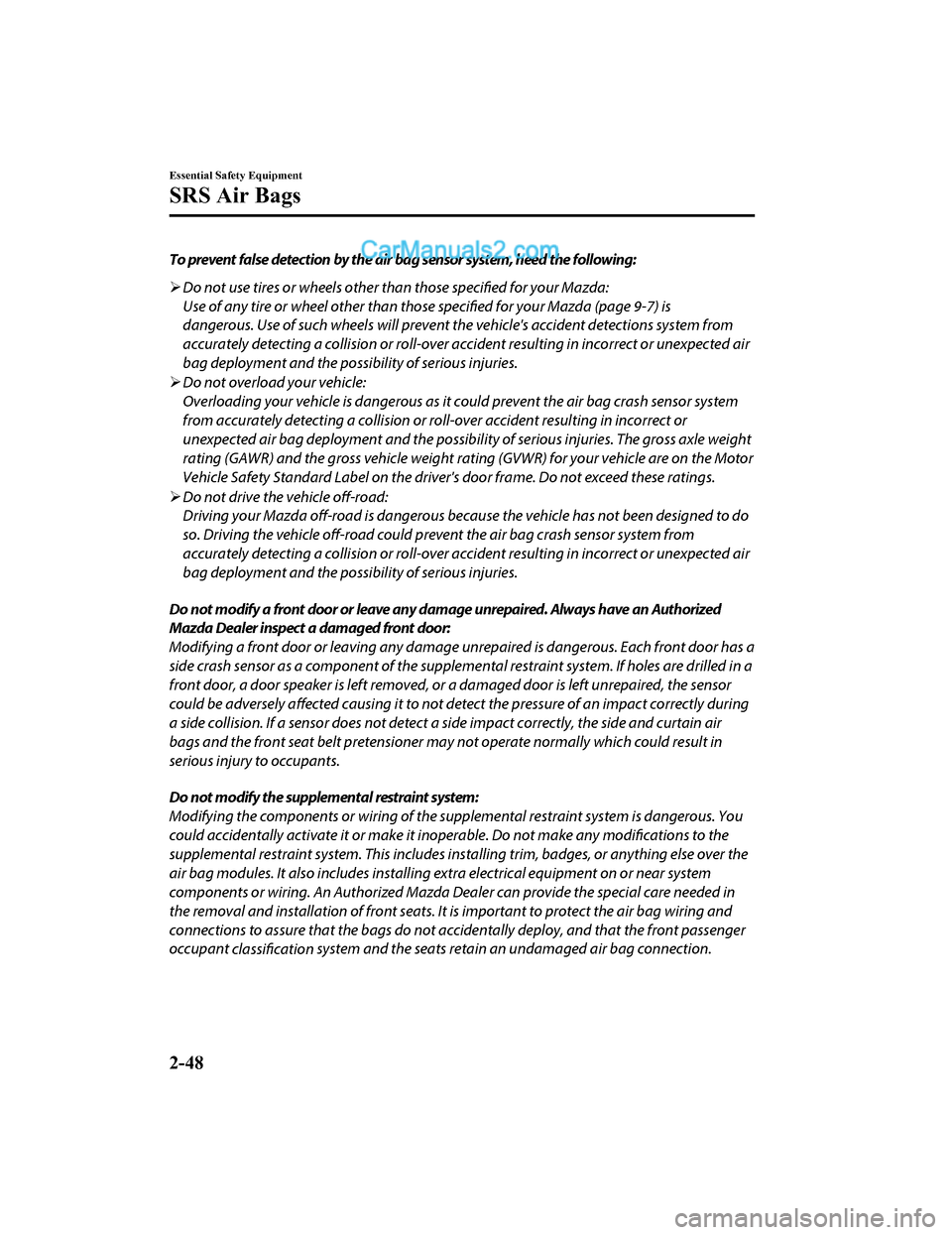
To prevent false detection by the air bag sensor system, heed the following:
Do not use tires or wheels other th an those specified for your Mazda:
Use of any tire or wheel other than thos e specified for your Mazda (page 9-7) is
dangerous. Use of such wheels will prevent th e vehicle's accident detections system from
accurately detecting a collision or roll-over accident resulting in incorrect or unexpected air
bag deployment and the possibility of serious injuries.
Do not overload your vehicle:
Overloading your vehicle is dangerous as it could prevent the air bag crash sensor system
from accurately detecting a collision or roll-over accident resulting in incorrect or
unexpected air bag deployment and the possibili ty of serious injuries. The gross axle weight
rating (GAWR) and the gross vehicle weight rati ng (GVWR) for your vehicle are on the Motor
Vehicle Safety Standard Label on the driver's door frame. Do not exceed these ratings.
Do not drive the vehicle off-road:
Driving your Mazda off-road is dangerous beca use the vehicle has not been designed to do
so. Driving the vehicle off-road could prev ent the air bag crash sensor system from
accurately detecting a collision or roll-over accident resulting in incorrect or unexpected air
bag deployment and the possibility of serious injuries.
Do not modify a front door or leave any da mage unrepaired. Always have an Authorized
Mazda Dealer inspect a damaged front door:
Modifying a front door or leaving any damage unrepaired is dangerous. Each front door has a
side crash sensor as a component of the suppleme ntal restraint system. If holes are drilled in a
front door, a door speaker is left removed, or a damaged door is left unrepaired, the sensor
could be adversely affected causing it to not de tect the pressure of an impact correctly during
a side collision. If a sensor does not detect a side impact correctly, the side and curtain air
bags and the front seat belt pretensioner may not operate normally which could result in
serious injury to occupants.
Do not modify the supplemental restraint system:
Modifying the components or wiring of the su pplemental restraint system is dangerous. You
could accidentally activate it or make it inoperable. Do not make any modifications to the
supplemental restraint system. This includes inst alling trim, badges, or anything else over the
air bag modules. It also includes installing extra electrical equipment on or near system
components or wiring. An Authorized Mazda Dealer can provide the special care needed in
the removal and installation of front seats. It is important to protect the air bag wiring and
connections to assure that the bags do not ac cidentally deploy, and that the front passenger
occupant classification system and the seats retain an undamaged air bag connection.
Essential Safety Equipment
SRS Air Bags
2-48
CX-5_8GN5-EA-17J_Edition1
2017-8-18 12:58:27
Page 124 of 628
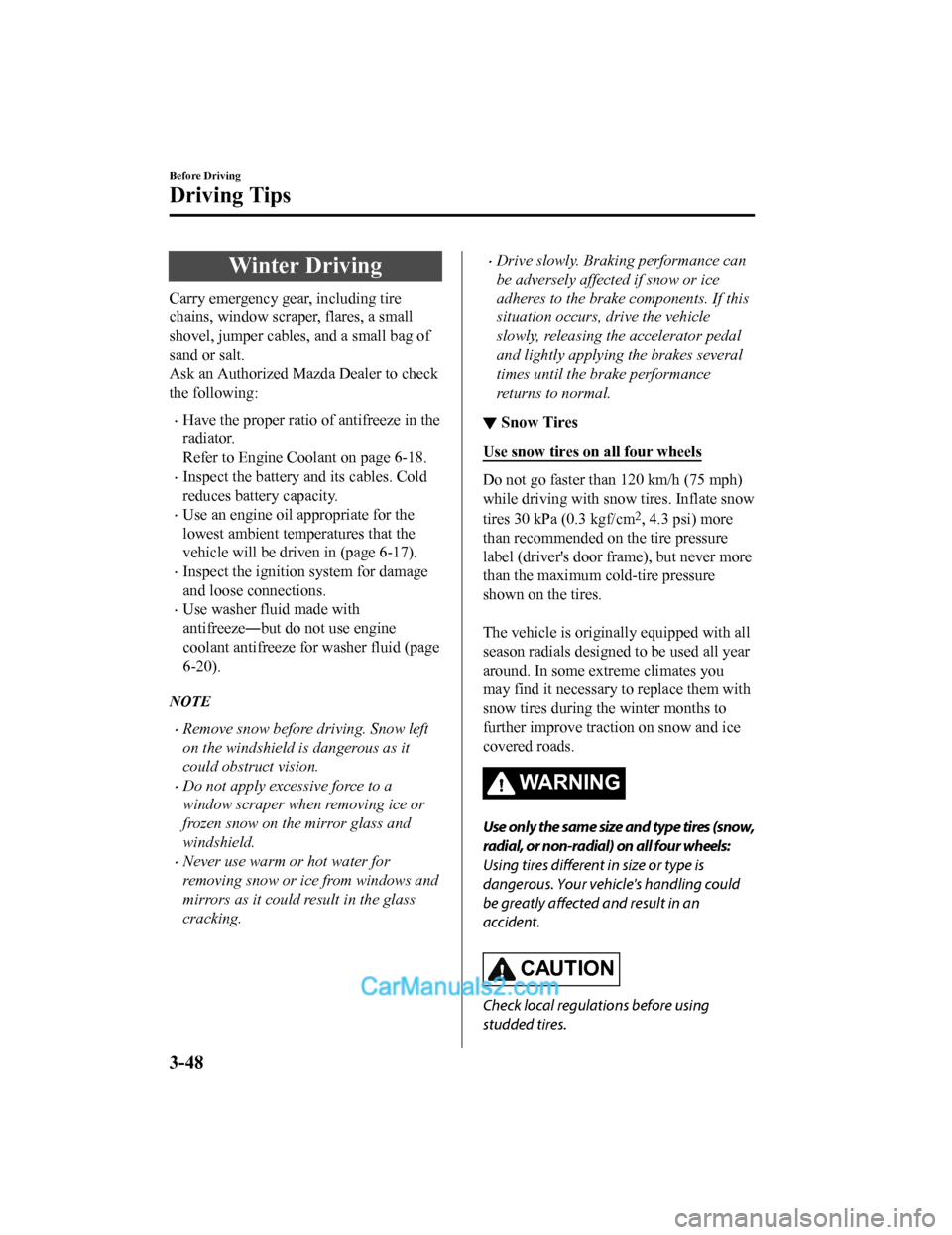
Winter Driving
Carry emergency gear, including tire
chains, window scraper, flares, a small
shovel, jumper cables, and a small bag of
sand or salt.
Ask an Authorized Mazda Dealer to check
the following:
•Have the proper ratio of antifreeze in the
radiator.
Refer to Engine Coolant on page 6-18.
•Inspect the battery and its cables. Cold
reduces battery capacity.
•Use an engine oil appropriate for the
lowest ambient temperatures that the
vehicle will be driven in (page 6-17).
•Inspect the ignition system for damage
and loose connections.
•Use washer fluid made with
antifreeze―but do not use engine
coolant antifreeze for washer fluid (page
6-20).
NOTE
•Remove snow before driving. Snow left
on the windshield is dangerous as it
could obstruct vision.
•Do not apply excessive force to a
window scraper when removing ice or
frozen snow on the mirror glass and
windshield.
•Never use warm or hot water for
removing snow or ice from windows and
mirrors as it could result in the glass
cracking.
•Drive slowly. Braking performance can
be adversely affected if snow or ice
adheres to the brake components. If this
situation occurs, drive the vehicle
slowly, releasing the accelerator pedal
and lightly applying the brakes several
times until the brake performance
returns to normal.
▼ Snow Tires
Use snow tires on all four wheels
Do not go faster than 120 km/h (75 mph)
while driving with sno
w tires. Inflate snow
tires 30 kPa (0.3 kgf/cm
2, 4.3 psi) more
than recommended on the tire pressure
label (driver's door frame), but never more
than the maximum c old-tire pressure
shown on the tires.
The vehicle is originally equipped with all
season radials designed to be used all year
around. In some extreme climates you
may find it necessary t o replace them with
snow tires during the winter months to
further improve traction on snow and ice
covered roads.
WA R N I N G
Use only the same size and type tires (snow,
radial, or non-radial) on all four wheels:
Using tires different in size or type is
dangerous. Your vehi cle's handling could
be greatly affected and result in an
accident.
CAUTION
Check local regulations before using
studded tires.
Before Driving
Driving Tips
3-48
CX-5_8GN5-EA-17J_Edition1 2017-8-18 12:58:27
Page 125 of 628
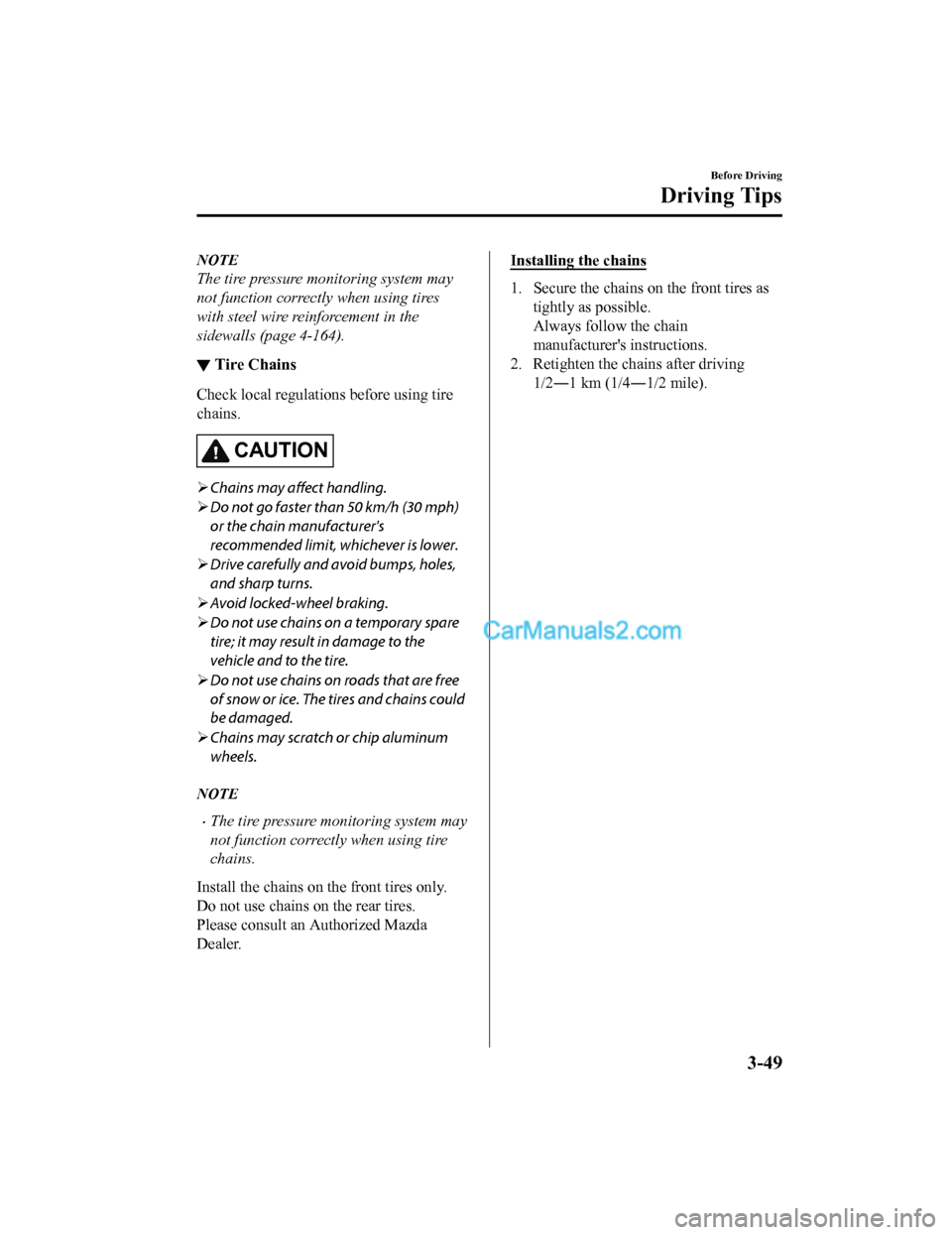
NOTE
The tire pressure monitoring system may
not function correctly when using tires
with steel wire reinforcement in the
sidewalls (page 4-164).
▼ Tire Chains
Check local regulations before using tire
chains.
CAUTION
Chains may affect handling.
Do not go faster than 50 km/h (30 mph)
or the chain manufacturer's
recommended limit, whichever is lower.
Drive carefully and avoid bumps, holes,
and sharp turns.
Avoid locked-wheel braking.
Do not use chains on a temporary spare
tire; it may result in damage to the
vehicle and to the tire.
Do not use chains on roads that are free
of snow or ice. The tires and chains could
be damaged.
Chains may scratch or chip aluminum
wheels.
NOTE
•The tire pressure monitoring system may
not function correctly when using tire
chains.
Install the chains on the front tires only.
Do not use chains on the rear tires.
Please consult an Authorized Mazda
Dealer.
Installing the chains
1. Secure the chains on the front tires as tightly as possible.
Always follow the chain
manufacturer's instructions.
2. Retighten the chains after driving 1/2―1 km (1/4―1/2 mile).
Before Driving
Driving Tips
3-49
CX-5_8GN5-EA-17J_Edition1 2017-8-18 12:58:27
Page 131 of 628
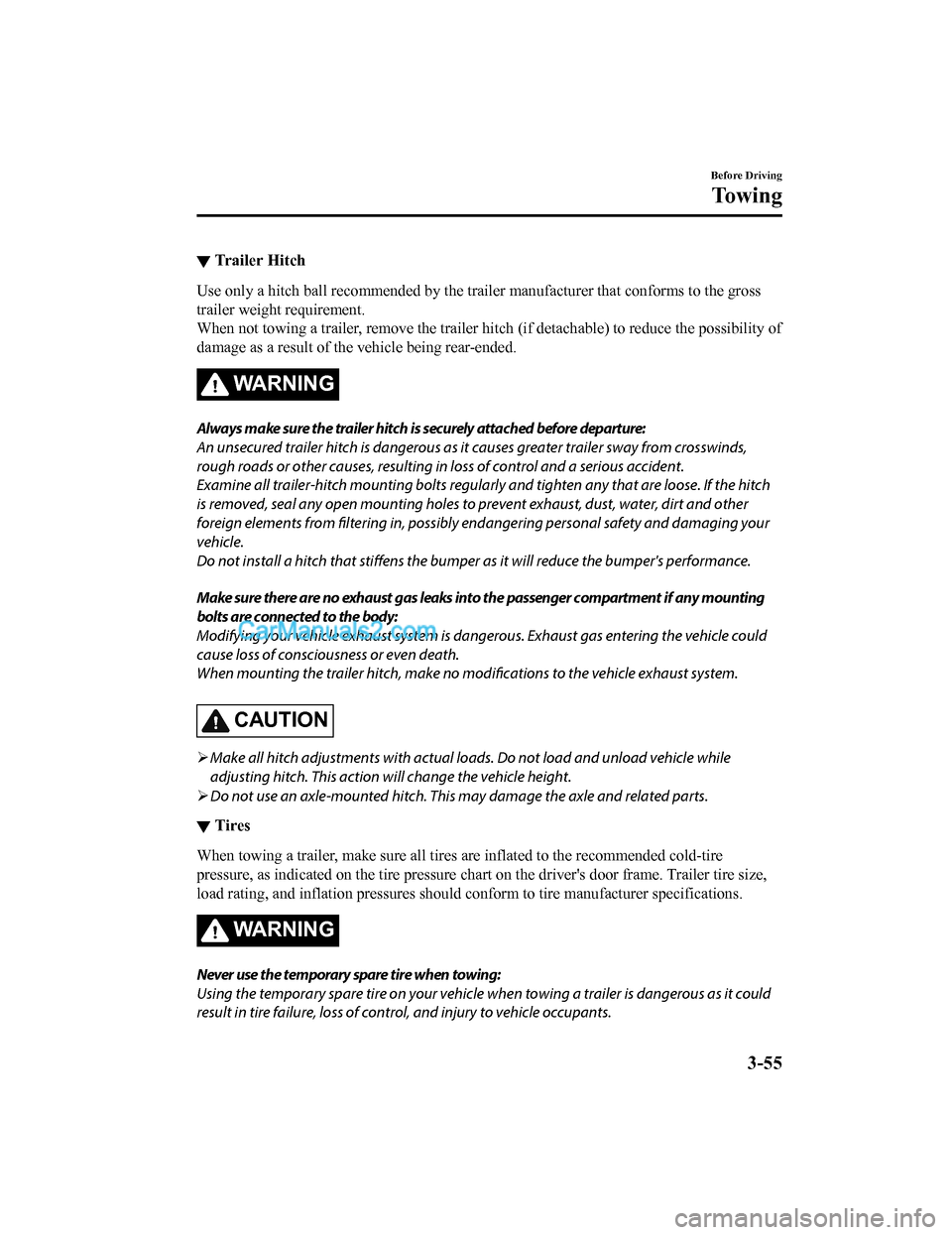
▼Trailer Hitch
Use only a hitch ball recommended by the trailer manufacturer that conforms to the gross
trailer weight requirement.
When not towing a trailer, remove
the trailer hitch (if detachable) to reduce the possibility of
damage as a result of the vehicle being rear-ended.
WA R N I N G
Always make sure the trailer hitch is securely attached before departure:
An unsecured trailer hitch is dangerous as it causes greater trailer sway from crosswinds,
rough roads or other causes, resulting in loss of control and a serious accident.
Examine all trailer-hitch mounting bolts regularly and tighten any that are loose. If the hitch
is removed, seal any open mounting holes to prevent exhaust, dust, water, dirt and other
foreign elements from filtering in, possibly en dangering personal safety and damaging your
vehicle.
Do not install a hitch that stiffens the bumper as it will reduce the bumper's performance.
Make sure there are no exhaust gas leaks into the passenger compartment if any mounting
bolts are connected to the body:
Modifying your vehicle exhaust system is dangerous. Exhaust gas entering the vehicle could
cause loss of consciousness or even death.
When mounting the trailer hitch, make no modifications to the vehicle exhaust system.
CAUTION
Make all hitch adjustments with actual load s. Do not load and unload vehicle while
adjusting hitch. This action w ill change the vehicle height.
Do not use an axle-mounted hitch. This may damage the axle and related parts.
▼Tires
When towing a trailer, make sure all tires are inflated to the
recommended cold-tire
pressure, as indicated on the tire pressure chart on the driver 's door frame. Trailer tire size,
load rating, and inflation pressu res should conform to tire manufacturer specifications.
WA R N I N G
Never use the temporary spare tire when towing:
Using the temporary spare tire on your vehicle wh en towing a trailer is dangerous as it could
result in tire failure, loss of control, and injury to vehicle occupants.
Before Driving
To w i n g
3-55
CX-5_8GN5-EA-17J_Edition1 2017-8-18 12:58:27
Page 138 of 628
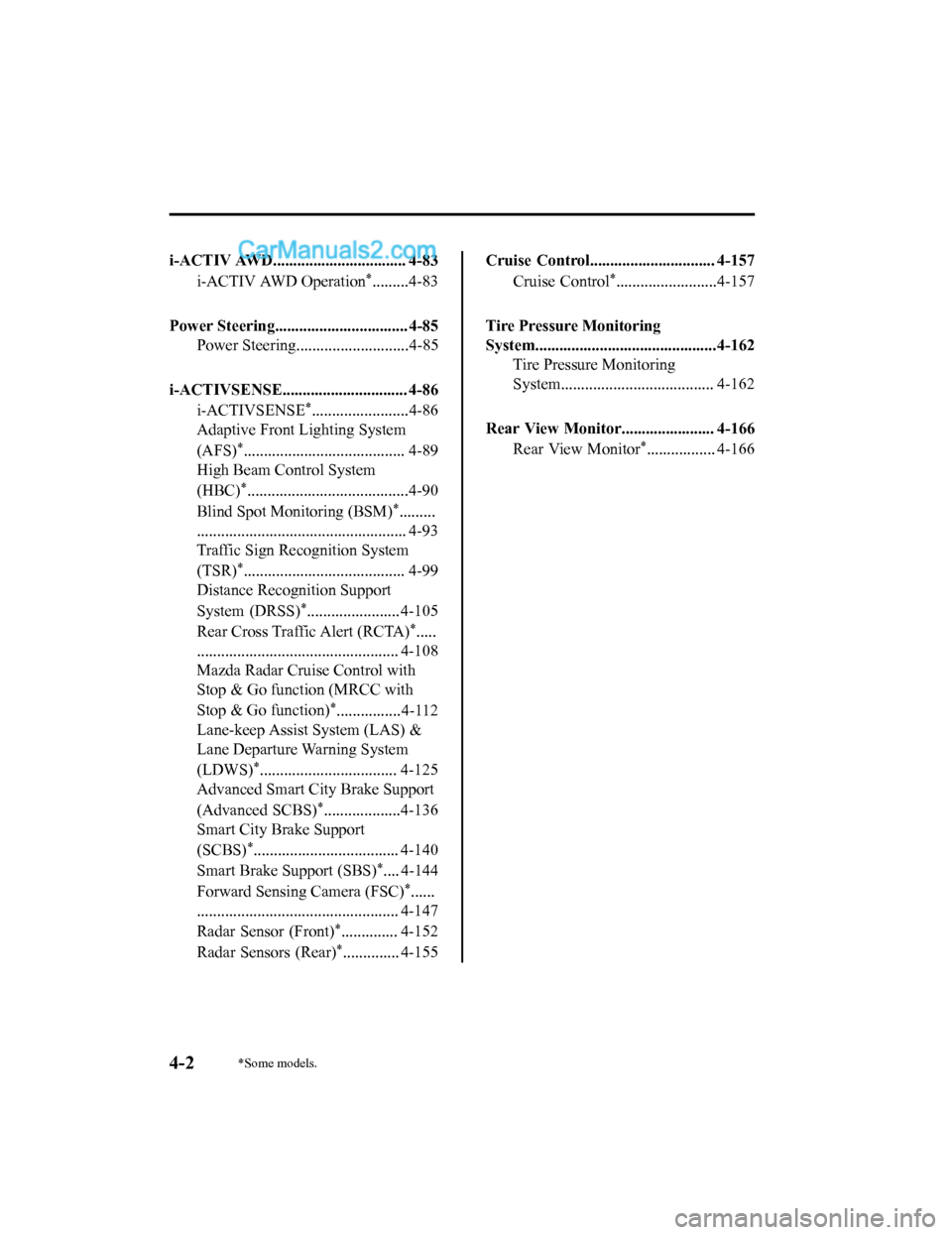
i-ACTIV AWD................................. 4-83i-ACTIV AWD Operation
*.........4-83
Power Steering................................. 4-85 Power Steering............................4-85
i-ACTIVSENSE............................... 4-86 i-ACTIVSENSE
*........................4-86
Adaptive Front Lighting System
(AFS)
*........................................ 4-89
High Beam Control System
(HBC)
*........................................4-90
Blind Spot Monitoring (BSM)
*.........
.................................................... 4-93
Traffic Sign Recognition System
(TSR)
*........................................ 4-99
Distance Recognition Support
System (DRSS)
*....................... 4-105
Rear Cross Traffic Alert (RCTA)
*.....
.................................................. 4-108
Mazda Radar Cruise Control with
Stop & Go function (MRCC with
Stop & Go function)
*................4-112
Lane-keep Assist System (LAS) &
Lane Departure Warning System
(LDWS)
*.................................. 4-125
Advanced Smart City Brake Support
(Advanced SCBS)
*...................4-136
Smart City Brake Support
(SCBS)
*.................................... 4-140
Smart Brake Support (SBS)
*.... 4-144
Forward Sensing Camera (FSC)
*......
.................................................. 4-147
Radar Sensor (Front)
*.............. 4-152
Radar Sensors (Rear)
*.............. 4-155
Cruise Control............................... 4-157 Cruise Control
*.........................4-157
Tire Pressure Monitoring
System.............................................4-162 Tire Pressure Monitoring
System...................................... 4-162
Rear View Monitor....................... 4-166 Rear View Monitor
*................. 4-166
4-2*Some models.
CX-5_8GN5-EA-17J_Edition1 2017-8-18 12:58:27
Page 167 of 628
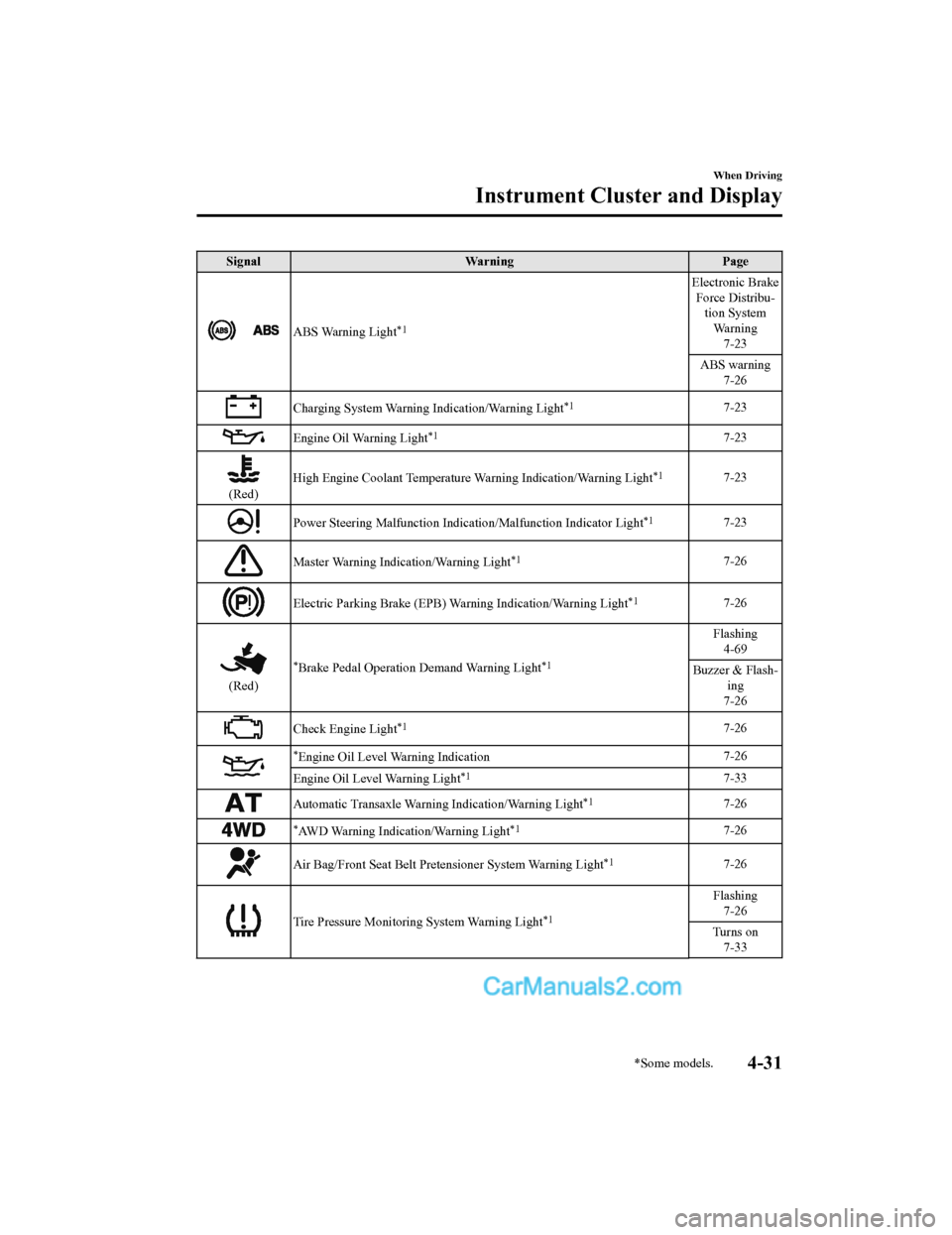
SignalWarning Page
ABS Warning Light*1
Electronic Brake
Force Distribu- tion System
Wa r n i n g 7-23
ABS warning 7-26
Charging System Warning Indication/Warning Light*17-23
Engine Oil Warning Light*17-23
(Red) High Engine Coolant Temperature
Warning Indication/Warning Light
*17-23
Power Steering Malfunction Indication/Malfunction Indicator Light*17-23
Master Warning Indication/Warning Light*17-26
Electric Parking Brake (EPB) Warning Indication/Warning Light*17-26
(Red)
*Brake Pedal Operation Demand Warning Light*1
Flashing
4-69
Buzzer & Flash- ing
7-26
Check Engine Light*17-26
*Engine Oil Level Warning Indication 7-26
Engine Oil Level Warning Light
*17-33
Automatic Transaxle Warning Indication/Warning Light*17-26
*AWD Warning Indication/Warning Light*17-26
Air Bag/Front Seat Belt Pretensioner System Warning Light*17-26
Tire Pressure Monitoring System Warning Light*1
Flashing 7-26
Turns on 7-33
When Driving
Instrument Cluster and Display
*Some models.4-31
CX-5_8GN5-EA-17J_Edition1 2017-8-18 12:58:27
Page 219 of 628

i-ACTIV AWD Operation*
AWD provides excellent drivability on
snow-covered and ice-packed roads, sand
and mud, as well as on steep slopes and
other slippery surfaces.
A system malfunction or operation
conditions are indicated by a warning.
Refer to Warning Indication/Warning
Lights on page 4-30.
WA R N I N G
Never spin a wheel that is off the ground:
Spinning a wheel that is off the ground as a
result of the vehicle being stuck or in a
ditch is dangerous. The drive assembly
could be seriously damaged which could
lead to an accident or could even lead to
overheating, oil leakage, and a fire.
▼ AWD Driving
WA R N I N G
Avoid sharp turns, excessive speed and
abrupt maneuvers when driving this
vehicle:
Sharp turns, excessive speed and abrupt
maneuvering of this vehicle is dangerous
as it could result in the increased risk of loss
of vehicle control, vehicle roll-over,
personal injury or death.
This vehicle has a higher center of gravity.
Vehicles with a higher center of gravity
such as utility and AWD vehicles handle
differently than vehicles with a lower center
of gravity.
Utility and AWD vehicles are not designed
for cornering at high speeds any more than
low profile sports cars are designed to
perform satisfactorily under off-road
conditions. In addition, utility vehicles have
a significantly higher rollover rate than
other types of vehicles.
Drive carefully when the vehicle is loaded
by lowering vehicle speed and applying the
brakes earlier:
Abrupt maneuvering and sudden braking
when driving a loaded vehicle is dangerous
as the driving behavior of a vehicle with a
high center of gravity is different when it is
loaded compared to when it is not, and
could result in the loss of vehicle control
and an accident.
▼Tires and Tire Chains
The condition of the ti
res plays a large role
in the performance of the vehicle.
Moreover, to prevent adverse effects to the
drive assembly, please note the following:
Tires
•When replacing tires, always replace all
front and rear tires at the same time.
•All tires must be of the same size,
manufacture, brand and tread pattern.
Pay particular attention when equipping
snow or other types of winter tires.
•Do not mix tread-worn tires with normal
tires.
•Inspect tire inflation pressures at the
specified periods adjust to the specified
pressures.
When Driving
i-ACTIV AWD
*Some models.4-83
CX-5_8GN5-EA-17J_Edition1 2017-8-18 12:58:27
Page 220 of 628

NOTE
Check the tire inflation pressure label
attached to driver's door frame for the
correct tire inflation pressure.
•Make sure to equip the vehicle with
genuine wheels of the specified size, on
all wheels. With AWD, the system is
calibrated for all four wheels being of
the same dimensions.
Tire chains
•Install tire chains to the front tires.
•Do not use tire chains on the rear
wheels.
•Do not drive the vehicle faster than 30
km/h (19 mph) with the tire chains
installed.
•Do not drive the vehicle with tire chains
on road conditions other than snow or
ice.
▼ To w i n g
If the vehicle requ
ires towing, have it
towed with all four wh eels completely off
the ground.
Refer to Towing Description on page 7-
20.
When Driving
i-ACTIV AWD
4-84
CX-5_8GN5-EA-17J_Edition1 2017-8-18 12:58:27
Page 236 of 628

Stop sign
40
Sign recognized and
displayed at same time
Active driving display indication
WA R N I N G
Always check the traffic signs visually while driving.
The TSR helps prevent the driver from overlookin g traffic signs and provides support for safer
driving. Depending on the weather conditions or problems with traffic signs, a traffic sign
may not be recognized or a traffic sign different from the actual traffic sign may be displayed.
Always make it your responsibility as a driver to check the actual traffic signs. Otherwise, it
could result in an accident.
NOTE
•The TSR does not operate if there is a malfunction in the Forward Sensing Camera (FSC).
•Under the following conditions, the TSR may not operate normally.
•An object placed on the dashboard is reflected in the windshield and picked up by the
camera.
•Heavy luggage is loaded in the luggage compartment or on the rear seat and the
vehicle is tilted.
•The tire pressures are not adjusted to the specified pressure.
•Tires other than standard tires are equipped.
•The vehicle is driven on the ramp and surrounding area to or from a rest area or a
tollgate on a highway.
•When surrounding brightness suddenly changes such as when entering or exiting a
tunnel.
When Driving
i-ACTIVSENSE
4-100
CX-5_8GN5-EA-17J_Edition1 2017-8-18 12:58:27
Page 262 of 628
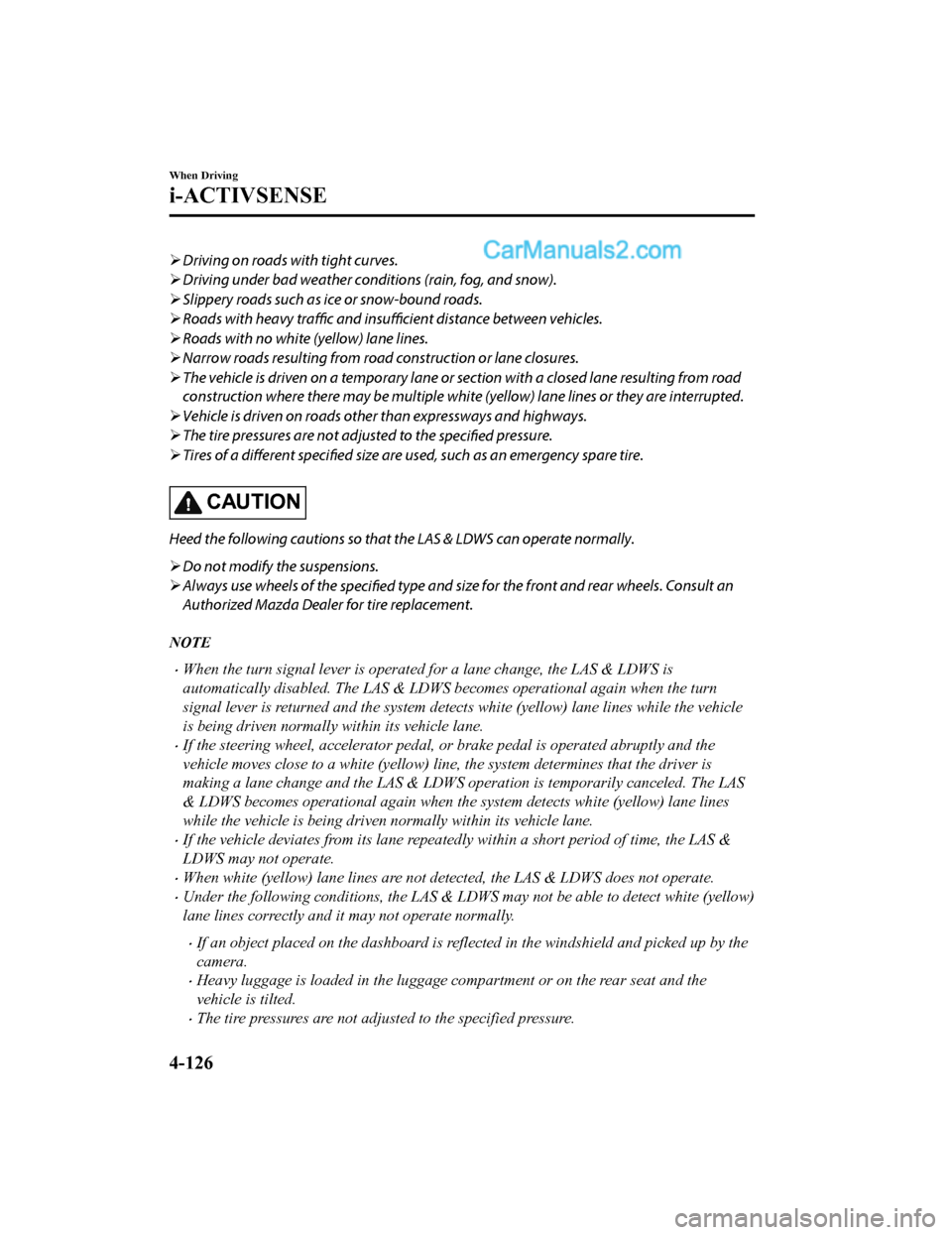
Driving on roads with tight curves.
Driving under bad weather conditions (rain, fog, and snow).
Slippery roads such as ice or snow-bound roads.
Roads with heavy traffic and insufficient distance between vehicles.
Roads with no white (yellow) lane lines.
Narrow roads resulting from road construction or lane closures.
The vehicle is driven on a temp orary lane or section with a closed lane resulting from road
construction where there may be multiple white (yellow) lane lines or they are interrupted.
Vehicle is driven on roads other than expressways and highways.
The tire pressures are not adjusted to the
specified pressure.
Tires of a different specified size are used, such as an emergency spare tire.
CAUTION
Heed the following cautions so that the LAS & LDWS can operate normally.
Do not modify the suspensions.
Always use wheels of the
specified type and size for the front and rear wheels. Consult an
Authorized Mazda Dealer for tire replacement.
NOTE
•When the turn signal lever is operated for a lane change, the LAS & LDWS is
automatically disabled. The LAS & LDWS becomes operational again when the turn
signal lever is returned and the system detects white (yellow) lane lines while the vehicle
is being driven normally within its vehicle lane.
•If the steering wheel, accelerator pedal, or brake pedal is operated abruptly and the
vehicle moves close to a white (yellow) line, the system determines that the driver is
making a lane change and the LAS & LDWS operation is temporarily canceled. The LAS
& LDWS becomes operational again when the system detects white (yellow) lane lines
while the vehicle is being driven normally within its vehicle lane.
•If the vehicle deviates from its lane repeated ly within a short period of time, the LAS &
LDWS may not operate.
•When white (yellow) lane lines are not detected, the LAS & LDWS does not operate.
•Under the following conditions, the LAS & LDWS may not be able to detect white (yellow)
lane lines correctly and it may not operate normally.
•If an object placed on the dashboard is reflected in the windshield and picked up by the
camera.
•Heavy luggage is loaded in the luggage compartment or on the rear seat and the
vehicle is tilted.
•The tire pressures are not adjusted to the specified pressure.
When Driving
i-ACTIVSENSE
4-126
CX-5_8GN5-EA-17J_Edition1 2017-8-18 12:58:27